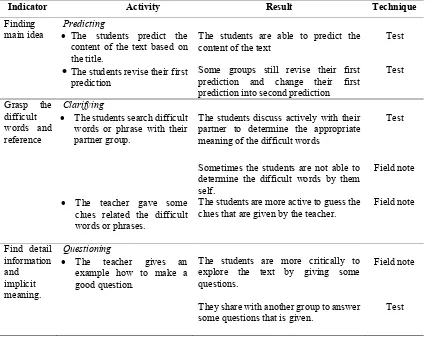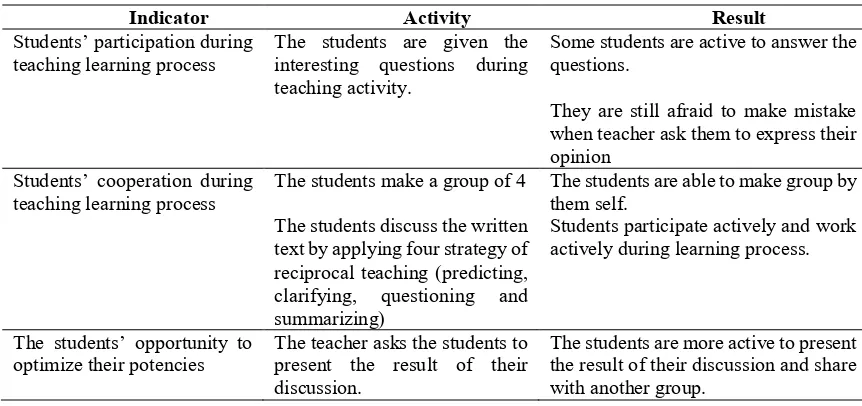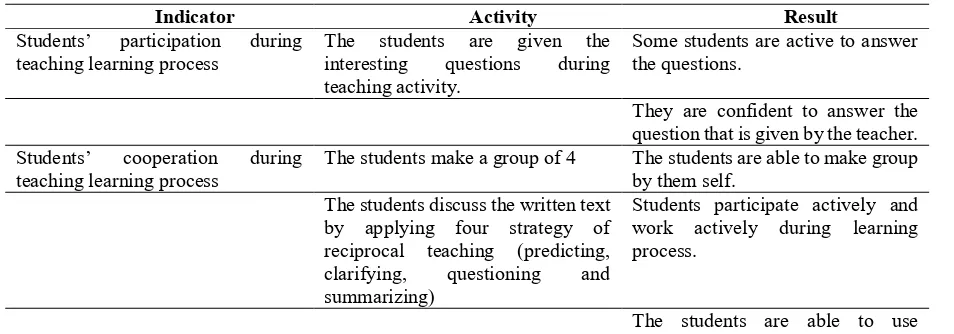THE USE OF RECIPROCAL TEACHING
TO IMPROVE STUDENTS’ READING COMPREHENSION SKILL
Yudo Dwi Purwoko*, A. Handoko Pudjobroto, Endang Setyaningsih English Education Study Program
Sebelas Maret University Surakarta
Email: [email protected]
The objectives of the research are: (1) to identify whether and to what extent the use of reciprocal teaching can improve the students’ reading comprehension skill; and (2) to describe what happens to the class climate when reciprocal teaching are implemented in the reading class. The research is carried out at SMP Negeri 1 Jaten Karanganyar. The subject of the research is the students of class VIIIG of SMP Negeri 1 Jaten in the academic year of 2012/2013. In collecting and analyzing the data, the researcher used qualitative and quantitative data. The research findings show that the use of reciprocal teaching improves students’ reading comprehension skill and classroom room climate. It can be seen from their interest and motivation in learning English, and reading mean score of pre-test 5.7 increased to 6.7 in post-test 1, and 7.6 in post-post-test 2.
Keywords: reading comprehension, reciprocal teaching
Grellet (1992: 7) says that reading as an active skill that constantly involves guessing, predicting, and asking oneself question. Good reading requires good thinking. Reading is not only pronouncing the letters printed but it uses cognitive process for obtaining its sense.
Besides Aebersold and Field (1994: 15) define that reading is what happens when people look at a text and assign meaning to the written text. They add that the text and the reader are two elements in make reading felt to be sensible. While Wallace (1996: 4) states that reading is interpreting means reacting to a written text as a piece of communication; assuming some communication intent on the writer’s part which the reader has some purpose in attempting to understand. Reader tries to understand what the writer intended to. In this activity, reader has particular purpose in doing it. Aebersold and Field further explain that the differences result of reading is
influenced by reader’s family, community, and cultural environment. Besides the difference result of reading also can be influenced by reader’s motivation, aptitude, and other personal characteristic.
Similarly, Silberstein (1997: 12) proposes that reading is interaction between the reader and the text is regarded as complex information processing skill in order to (re) create meaningful discourse. Reader processes the information he/she gets based on the skill he/she has. It is reinforced by Alyousef (2005: 144) in Octaviana states that reading is seen as communicative activity where the reader understands the text by using linguistic knowledge and schematic knowledge. Besides, Davis in Vacca (1989: 20) explains that
finding answer to question answered explicitly or in paraphrase in the passage, drawing inferences from the content, recognizing a writer’s purpose, attitude, tone, and mood, and following the structure of a passage”.
Likewise Anderson in Aebersold and Field (1994: 16) states that successful readers can comprehend the text well if they are able to: 1) recognize words quickly, 2) analyze unfamiliar words, 3) read for meaning, concentrate or constructing meaning, 3) guess about the meaning of text, 4) distinguish main ideas of the text. Furthermore, Kennedy (1997: 12) defines that
“reading comprehension as a thought process through which readers become aware of an idea, understand it in terms of their experiential background, and interpret it in relation to their own needs and purposes”
Based on the definition, it can be concluded that reading comprehension is process of understanding text that began from words, phrases, sentences, and paragraphs to grasp the meaning of words, phrases, sentences, and paragraphs to infer the meaning of the whole text.
Reading comprehension requires some skills; (1) finding the main idea, (2) mentioning the detail information and (3) the implied information, (4) grasping the meaning of words, (5) and the meaning of references.
However, those skills are yet to master by students. Based on the result of pre-observation, the researcher still found that the students are still difficult to (1) find main idea; (2) find the detail information; (3)
interpret and grasp meaning of vocabulary; (4) guess the implicit meaning; (4) grasp the appropriate reference.
The researcher realizes that the problems should be solved by using appropriate approach in order to improve students’ reading comprehension skill. There are so many approaches of teaching reading such as Group Investigation, Reciprocal Teaching, Jig Saw, Think-Pair-Share etc. Based on the specific problems that faced by students above, the researcher believes that reciprocal teaching is the most appropriate approach that can help students to solve the problems.
Reciprocal teaching refers to an instructional activity that takes place in the form of a dialogue between teachers and students regarding segments of text. The dialogue is structured by the use of four strategies: predicting, clarifying, question generating and summarizing. Palincsar & Brown, (1984) in Slavin (1991: 175) explains that four activities are incorporated into the technique: prediction, clarifying misleading or complex section of the text, questioning, and summarizing.
There are four strategies of reciprocal teaching technique. Palincsar and Brown (1984) mentions the strategies of reciprocal teaching, they are:
2. Summarizing is the process of identifying the important information, themes and ideas within a text and integrating these into a clear statement that communicates the essential meaning of the text. Summarizing may be based on a single paragraph, a section of text, or a whole passage. Summarizing provides the students to create a context for understanding the specifics of a text.
3. Clarifying involves the identification and clarification of unclear, difficult, or unfamiliar aspects of a text. These aspects may include unfamiliar sentence or passage structure, vocabulary, unclear references, or concepts. Clarifying provides the motivation to remediate confusion through re-reading, the use of context in which the text was written and/or read, and the use of external resources (e.g., dictionary or encyclopedia).
4. Predicting involves combining the reader’s prior knowledge, new knowledge from the text, and the text’s structure to create hypotheses related to the direction of the text and the author’s purpose in writing.”
Research has shown that when reciprocal teaching is implemented, learners will make substantial gains in their comprehension skills (Education Ministry of New Zealand, 2004). Besides, the strategy
training allows them to gain more self confidence and motivation to read and even expertise as they apply the four strategies to variety of text (Ormrod, 1998: 616).
RESEARCH METHODS
The research method that is used by researcher is classroom action research. Ebbut (in Hopkin, 1993:45) defines that action research as the systematic study of attempts to improve educational practice by groups of participants by means of their own
practical actions and by means of their own reflection upon the effects of those actions.
Further classroom action research consists of four essential moments. They are: planning, action, observation and reflection (Kemmis and McTaggart in Burn, 1984: 32). The process can be seen in the following procedures; (1) identifying the problem: the researcher used pre-test, classroom observation, interviewing the English teacher and the students in finding problems, (2) planning: the researcher prepared one lesson plan in each meeting. In the first and the second cycle, the researcher planed two meeting, (3) action Implementation: in carrying out the action research, he implemented the lesson plan and deliberately all the things written in the lesson, (4) observation: the observation phase was conducted during the teaching learning activity in order to record the activities happened in the classroom, (5) reflection: after the implementation of the action, the researcher reflects critically on what has happened after teaching learning.
photographs: the photographs are used to take a picture from students’ activity during teaching learning activity; (4) interview: the interview is used to identify the problem and the source of the problem faced by the students in learning reading activity; 5) questionnaire: the researcher contributes questionnaire to the students to know the students’ opinion and feeling during their learning reading activity; (6) test: the kind of test that used by researcher in this research are essay multiple choice. It is given before (pre-test) and after (post-test) the action. In the pre-test, the students are asked to answer some questions based on text.
The data obtained from observation, field notes, photographs, interview and
questionnaire are analyzed following the procedure of assembling the data, coding the data, comparing the data, building interpretation and reporting the outcome.
Meanwhile, the data gained from test are analyzed by comparing the mean score of post test 2 and post test 1.
RESEARCH FINDINGS AND
DISCUSSION
The results of the research show that the implementation of reciprocal teaching activity was able to improve students reading comprehension. Besides, it improves classroom climate. The improvements can be seen in the research findings table below:
Cycle 1
Table 1. Improvements of Students’ Reading Comprehension
Indicator Activity Result Technique
Finding main idea
Predicting
The students predict the
content of the text based on the title.
The students are able to predict the content of the text
Test
The students revise their first prediction
Some groups still revise their first prediction and change their first prediction into second prediction
Test
Grasp the difficult words and reference
Clarifying
The students search difficult words or phrase with their partner group.
The students discuss actively with their partner to determine the appropriate meaning of the difficult words
Test
Sometimes the students are not able to determine the difficult words by them self.
Field note
The teacher gave some
clues related the difficult words or phrases.
The students are more active to guess the clues that are given by the teacher.
Field note
Find detail information and implicit meaning.
Questioning
The teacher gives an
example how to make a good question.
The students are more critically to explore the text by giving some questions.
Field note
They share with another group to answer some questions that is given.
Find detail information
Summarizing
The teacher give an example
how to make summary by choosing an important point each paragraph
The students are able to determine the important point of each paragraph.
Field note
The students summarize
what they read.
The students discuss with their partner group to summarize what they read.
Test
Some of group are still confused how to make summary by recalling what they read before
Field note
Table 2. Improvements of Classroom Climate during Teaching Reading Activity
Indicator Activity Result
Students’ participation during teaching learning process
The students are given the interesting questions during teaching activity.
Some students are active to answer the questions.
They are still afraid to make mistake when teacher ask them to express their opinion
Students’ cooperation during teaching learning process
The students make a group of 4 The students are able to make group by
them self. The students discuss the written
text by applying four strategy of reciprocal teaching (predicting,
clarifying, questioning and
summarizing)
Students participate actively and work actively during learning process.
The students’ opportunity to optimize their potencies
The teacher asks the students to present the result of their discussion.
The students are more active to present the result of their discussion and share with another group.
Further, the result of posttest reading comprehension 1 is higher than pre test. It can be seen in the table below:
Table 3. Students’ Reading Comprehension Mean Score Cycle 1
Kind of test Pre-Test Post-Test
Multiple Choice 5.7 6.7
From the research findings, both reading comprehension or classroom climate, it can be concluded that the use of reciprocal teaching strategy is powerful way for reading class. Meanwhile, from the result of the findings also, the researcher felt that the strategy was not optimal. The case was
caused from students’ motivation in implementing the strategy. They were still confused to implement the four of strategy of reciprocal teaching. Based on it, the researcher planed to revise the problem in cycle2
Cycle 2
Indicator Activity Result Technique
content of the text based on the title.
The students are able to predict the content based on the title of text.
Test
The students revise their first prediction
Some groups still revise their first prediction and change their first prediction into second prediction
Test
The students clarify difficult words or phrase with their partner group.
The students discuss actively with their partner to determine the appropriate meaning of the difficult words
Test
The students are more active to ask with the teacher and their partner group.
Field note how to make a question.
The students are more critically to answer some questions that is given.
Field note
They are more critically to explore the detail information of the text by looking the picture. choosing an important point each paragraph
The students are able to determine the important point of each paragraph.
Test
The students discuss with their partner group to summarize what they read
Test The students summarize what
they read.
Some of group are still confused how to make summary by recalling what they read before
Field note
Table 5. Improvements of Classroom Climate during Teaching Reading Activity
Indicator Activity Result
Students’ participation during teaching learning process
The students are given the
interesting questions during
teaching activity.
Some students are active to answer the questions.
They are confident to answer the question that is given by the teacher.
Students’ cooperation during
teaching learning process
The students make a group of 4 The students are able to make group
by them self. The students discuss the written text
by applying four strategy of reciprocal teaching (predicting,
clarifying, questioning and
summarizing)
Students participate actively and work actively during learning process.
applying predicting, clarifying, questioning and summarizing. The students’ opportunity to
optimize their potencies
The teacher asks the students to
present the result of their
discussion.
The students are more active to present the result of their discussion and share with another group. The students are able to accept the opinion from another group.
From the result findings in cycle 2, the researcher concluded that the implementation of reciprocal teaching strategy was optimal. It can be seen on the research findings table above. There is a
significant improvement of students’ reading comprehension and classroom climate. Further, the result of improvement of students’ reading comprehension can be drawn in the table below:
Table 6. Students’ Reading Comprehension Mean Score Cycle 2
Kind of test Pre-Test Post-Test 1 Post-Test 2
Multiple Choice 5.7 6.7 7.6
From the table above, it shows that there is an improvement of students’ reading comprehension score from the pre test, post test 1 and post test 2. It also shows that the use of reciprocal teaching strategy can improve classroom climate.
Reciprocal teaching technique develops the abilities of students with special needs to learn meaningful. Besides, the reciprocal teaching is flexible and can be modified by integrating other strategies like cooperative teaching, whole class discussion and dialogue in order to increase students’ participation and active their roles in teaching learning process. It supported by Hamzah. A. Omari (2010), he says that strategies of reciprocal teaching are explicitly easy to be understood. Palincsar and Brown in Carl. A. Young (2006) used reciprocal teaching technique to teach the students. The strategy involved predicting, clarifying, questioning and summarizing. The result of the study shows that the use of reciprocal teaching strategy is capable to improve students’ reading comprehension.
CONCLUSION AND SUGGESTION Based on the research findings and discussion above, the researcher concluded that reciprocal teaching strategy was able to improve students’ reading comprehension and students’ attitude. Besides, the result also can answer the problem statement on the previous chapter. The problem statements are; Does and what extent reciprocal teaching improves students’ reading comprehension? And how is the situation when reciprocal teaching is implemented in the teaching reading activity?.
achievement can be seen in the main score of each cycle.
From the second questions of problem statement, the researcher concluded that the use of reciprocal teaching is able to help students more active during teaching learning. The students are more critical about the text by giving some questions. They are not afraid to ask and give their opinion during teaching reading activity. Moreover, the students pay more attention when the researcher was explaining the material.
BIBLIOGRAPHY
Aebersold, Jo Ann and Feld, Mary Lee. 1994. From Reader to Reading Teacher. Cambridge: Cambridge University Press.
Burns, Anne. 1984. Collaborative Action Research for English Language Teacher. Cambridge: Cambridge University.
Vacca, Richard. 1989. Content Area Reading. Harper Collins: Kent State University
De Boer, John and Dallman. 1964. The Teaching of Reading. Chicago: Holt. Rinchant and Winston, Inc.
Education Ministry of New Zealand. 2004.
Reciprocal Teaching. Retrieved
March 14, 2012. From
http/English.unitecnology.ac,zn/reso urces/resources.html.
Grellet, Frncoise. 1992. Developing Reading Skill: A Practical Guide to Reading
Comprehension Exercises.
Cambridge: Cambridge University Press.
Hopkins, David. 1985. A Teacher’s Guide to
Classroom Research. Philadelphia: Open University Press.
Kennedy, Eddie C. 1997. Methods of Teaching Developmental Reading.
New York: FE Peacock Publisher Inc.
Lidya, Octaviana. 2010. Improving Students’ Reading Comprehension Using Group Investigation: An Classroom Action Research.
Unpublished Thesis: Sebelas Maret University Surakarta.
Ormrod, Jeanne Ellis. 1998. Educational Psychology 2nd Edition. New Jersey: Prentice Hall, Inc.
Omari, Hamzah. 2010. Using the Reciprocal Teaching Method by Teachers at Jordanian School. It is accessed on August 14th, 2012 from http:/ www.eurojournals.com/ejss_15_1_03 .pdf
Palincsar, A.S & Brown, A.L. (1984).
Reciprocal Teaching in
Comprehension Fostering and Comprehension Reading Activities. In Cognition and Instruction, 1 (2) 117-175.
Silberstein, Sandra. 1997. Technique and Resourches in Teaching Reading. New York: Oxford University Press.
Slavin, Robert E. 1991. Educational Psychology: Theory into Practice 3rd edition. Massachussets: Allyn and Bacon
Wallace, Catherine. 1996. Reading. New York: Oxford University Press
Young, Carl. 2006. Reciprocal Teaching for Reading Comprehension in Higher Education; A Strategy for Fostering the Deeper Understanding of Text. It is accessed on August 14th, 2012 from


